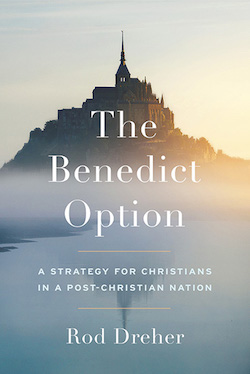 The Benedict Option: A Strategy for Christians in a Post-Christian Nation, by Rod Dreher. New York: Sentinel, 2017, 262 pages, $25.00. Reviewed by John R. Muether (a ruling elder at Reformation Orthodox Presbyterian Church, Oviedo, Florida, library director at Reformed Theological Seminary in Orlando, Florida, and historian of the Orthodox Presbyterian Church).
The Benedict Option: A Strategy for Christians in a Post-Christian Nation, by Rod Dreher. New York: Sentinel, 2017, 262 pages, $25.00. Reviewed by John R. Muether (a ruling elder at Reformation Orthodox Presbyterian Church, Oviedo, Florida, library director at Reformed Theological Seminary in Orlando, Florida, and historian of the Orthodox Presbyterian Church).
Rod Dreher, senior editor of The American Conservative, writes an engaging and thought-provoking appeal for American Christians to rethink their calling amid an increasingly hostile post-Christian world. The church can no longer sleep, as it has, through cultural revolutions—social, sexual, and technological. Many of the dislocating effects of modernity seemed unthreatening as long as they were championed as progress. But the culture wars have been lost, and the Judeo-Christian worldview now faces stiff opposition. We must now prepare for what’s coming (77), beyond cultural marginalization to conditions that might invite persecution.
The title invokes the story of the eighth-century saint, Benedict of Nursia, whose withdrawal into monastic seclusion in the wake of the barbarian invasion of Europe proved improbably to be the means by which the church was preserved and Western civilization rebuilt. We are facing barbarians today, warns Dreher, both in the overt expressions of opposition and the “sneaky” forms of secularism such as Moralistic Therapeutic Deism (10). Dreher recommends that Christians revisit this “Benedict option,” because “the humble Benedictine way is such a potent counterforce to the dissolving currents of modernity” (23). Some critics challenge a call to retreat into a Christian ghetto, but there is actually little of that rhetoric in the book. The task of the church to be both a sign of contradiction to the world and a sign of hope does not necessarily entail withdrawal. Rather, Dreher urges engagement in local culture and faithfulness in small ways, while waiting for God to produce fruit in his time.
Here is where conservative Protestantism comes up short for the author, a former Methodist who converted to Eastern Orthodoxy. The Protestant Reformation did its part in the rise of modern fragmentation and unbelief. Dreher leans on the work of Brad Gregory (in The Unintended Reformation, 2015), and he repeats the standard Roman Catholic charges of the interpretive chaos of Protestantism: “No Reformer believed in private interpretation of Scripture, but they had no clear way to discern whose interpretation was the correct one” (32). But of course, that is what confessions serve to provide. Having succumbed to individualism, modern evangelicalism is especially unable to witness to a post-Christian culture, because “you cannot give what you do not possess” (102). Dreher even describes a congregation of the Presbyterian Church in America that is beset by vast biblical illiteracy with few signs of a culture of discipleship.
Chapter five outlines a starter set of practices that shape discipline for the life and witness of the church, such as prayer, catechesis, liturgical worship, self-denial, and hospitality, altogether a very ordinary list that will produce healthier communities of faith. Later in the book there are additional suggestions oriented around the challenge of media ecology, including the practice of a “digital Sabbath” and keeping social media out of public worship. Aside from non-Reformed expressions of piety here and there (“fasting according to the church calendar”), these are means of shaping hearts heavenward.
The longest chapter in the book is on Christian education. Dismissing public schools as wastelands of progressive sexual ideology, Dreher commends particularly the “new counterculture found in classical Christian schools” (173). Here the author tends to tip the scales by comparing the ideal of classical education with the messy history of other forms of Christian schooling. (Where classical education is not available, Dreher gives a nod to homeschooling.)
But why is the Benedict Option so urgent for us now? Do our uniquely desperate times call for these measures? The main flaw in Dreher’s argument for his “church in exile” lies in misuse of the biblical metaphor of homelessness. In the chapter on politics we read that the church’s cultural powerlessness demands a “new politics,” one particularly suited for our fragile and fragmented age (83). It should be prudent and subtle, polite and respectable, and focused on the local church and community. Purging ourselves of consumerist distortions of corporate life, the church needs “forms of living” that reinforce our distinctiveness as “strangers in exile.” But only now, to cope with these dark times? Shouldn’t the new covenant community always aspire to those virtues?
It is not true that the church in the West is now suddenly entering life in Babylon. As citizens of the kingdom, we are always and everywhere called to be strangers in a strange land, living under ungodly regimes that sometimes subject God’s people to persecution. The biblical term for that is Babylon. Our calling is to seek the welfare of Babylon, and so Jeremiah’s letter to the exiles (29:4–7) is his letter to new covenant exiles. Peter makes this clear (1 Peter 1:1, 2:11), whether the conditions of exile are friendly, indifferent, or hostile to the Christian way of life. If our city of exile prospers, we have helped to build a better Babylon, but it remains Babylon, and we are still homeless. We dare not imagine we can turn it into Jerusalem.
Exile, then, is not a cultural condition that yields a unique strategy. It is a redemptive-historical category that invites us to find our life hidden in Christ in the heavenlies. Still, this book remains a worthwhile read. Its real value is found in Dreher’s reminder of the character of a community of faith necessary to conduct the task of Christian formation in all ages. It must be a close community (although Dreher weakens his case, it seems, by his appeal to thin expressions of ecumenicity, such as the 1994 “Evangelicals and Catholics Together”). Thickness demands order, which he rightly identifies as a fundamental act of cultural resistance.
In describing the church as an island of sanctity and stability in the raging sea of modernity, Dreher could have made his appeal instead by turning to John Calvin, whom he does not cite. For Calvin, the cursed world has lost the order with which it was endowed at creation, and a battle now rages between rest and restlessness, between tranquility and confusion, or between the permanent glory of the world to come and the transitoriness of this passing age. Order can only be found in one place: “There is no stability in the whole of the universe,” wrote Calvin, “except for the church, which is built on the foundation of God’s word.”[1] The church disciplines us by reshaping our desires and our loves, and far from anti-worldly escapism, the church enables us to see the world as it truly is.
We can follow a sixteenth-century Reformer just as much as an eighth-century monastic to find the church which Dreher yearns to see, that “will live in small circles of committed believers who live the faith intensely, and who will have to be somewhat cut off from mainstream society for the sake of holding on to the truth” (4).
Endnote
[1] Cited by Herman J. Selderhuis, Calvin’s Theology of the Psalms (Grand Rapids: Baker Academic, 2007), 67, where he offers a particularly helpful analysis on Calvin’s teaching on order.
